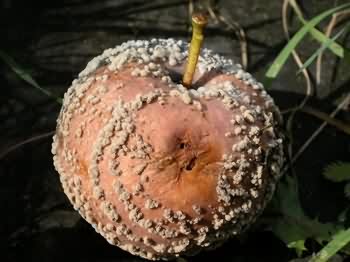Diseases
Monilia fructigena Pers. - Brown Fruit Rot
Systematic position.
Division Deuteromycota, class Hyphomycetes, order Hyphomycetales, family Moniliaceae, genus Monilia.Biological group.
This species is a biotroph.Morphology and biology.
The fungus over-winters on fruits in mycelium. In spring, this mycelium develops pads consisting of fungal spores; the latter are oval or lemon-shaped, colorless, 17-25 microns long and 10-15 microns wide, aggregated in furcated chains. With the help of wind, rain, or insects the conidia settle on young and mature fruits, causing the lesions that are usually small and brown, subsequently covering the entire surface. The pulp of the affected fruit is softened, brown, but remains juicy, sweetish, with an alcoholic taste. Eight to ten days after infestation, small dense gray-yellow pads of conidial sporulation of fungi form on surface in concentric circles. The affected fruits gradually mummify, fall down or hang on branches during winter.Distribution.
The disease is widely distributed in all fruit-growing regions of the Russian Federation and other countries of the former USSR; but the harmfulness of the disease is not evident everywhere. Epiphytotic development of the Fruit Rot (one time in 2 years infection reaches 50-100%) is observed in northwestern, central regions, in areas of southern Ural, in Altai, Siberia, Krasnodar and Stavropol Territories, republics of Adygea, Kabardino-Balkaria, along the Black Sea coast. Moderate development of the disease (1 time in 3 years infection reaches 30-50%) occurs in Transcaucasia, the Far East, Moldova, southern Ukraine and Byelorussia. At the lowest level of severity (1 time in 5 years infection reaches 10-30%) the disease develops in the Almaty region of fruit growing of Kazakhstan, in Lithuania.Ecology.
Infection of fruits by the Fruit Rot occurs at temperatures of 24-28.C and relative air humidity of 75%.Economic significance.
Disease causes a premature rotting of fruits, sharply reducing the crop yield. Methods of protection include the use of less susceptible plant cultivars, sanitary actions directed at decreasing the infection sources (collection and destruction of affected fruits), and chemical control.Reference citations:
Ablakatova A.A. 1965. Mycoflora and the main fungal diseases of fruit plants in the south of the Far East. Moscow-Leningrad: Nauka. 146 p. (In Russian)Burkeev D.D., Trusevitsh A.W., Burkeev Ya.D. 2000. Ascigerous stage of Monilia fructigena is found in the Kursk Region. Zashchita i Karantin Rastenii, 1: 36-37. (In Russian)
Grigorevich L.N. 1997. Incidence and harmfulness of the main diseases of apple and pear in gardens of Byelorussia cultivated under intensive technology. Actual problems of phytovirology and plant protection. Minsk: Ekaunt. 117-118 p. (In Russian)
Ismailova E.T., Koishibaev M. 1999. Fruit Rot of fruit crops. Zashchita i Karantin Rastenii, 9: 16-17. (In Russian)
James P.W., Hawksworth D.L. 1971. Ainsworth & Bisby.s dictionary of the fungi. 6th edition. Kew: CAB International. 663 p.
Onufreichik N.G. 1974. Efficacy of Policarbacin in control of moniliosis of apple at different repetition of treatments of garden. Rational problems of plant protection from pests, diseases and weeds. Gorki: Byelorussian agricultural academy. 27-31 p. (In Russian)
Rashinskene A. 1974. Fruit Rot of apple in garden and resistance of some cultivars of apple in Lithuanian SSR. Short results of scientific researches on plant protection. Riga: Management NTI. 77-78 p. (In Russian)
Smolyakova V.M. 2000. Fungal diseases of fruit trees in South Russia. Krasnodar: Vest.. 192 p. (In Russian)
Vishnevetskaya A.M. 1969. Some factors of resistance of apple to Fruit Rot. Works of Vth All-Union meeting on immunity of plants. Kiev: VASKhNIL, USKhA. 45-50 p. (In Russian)
© Bilder I.V.


